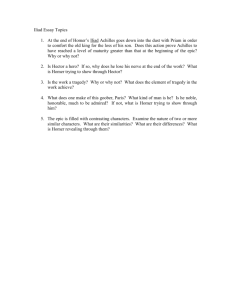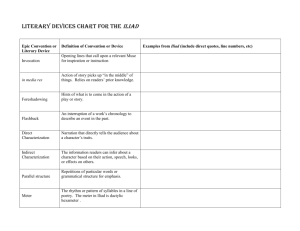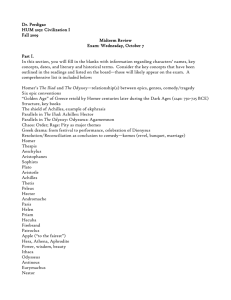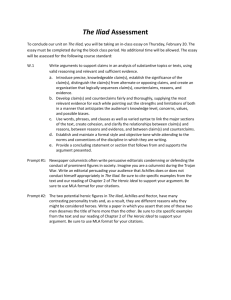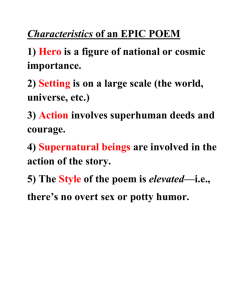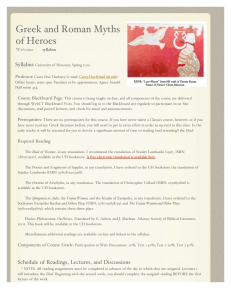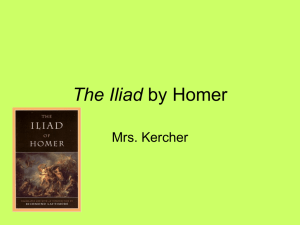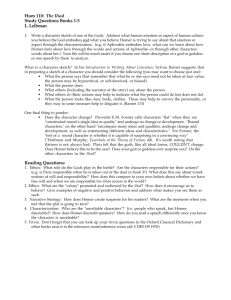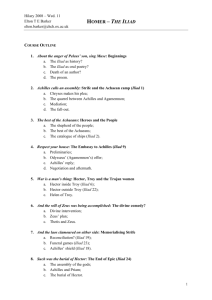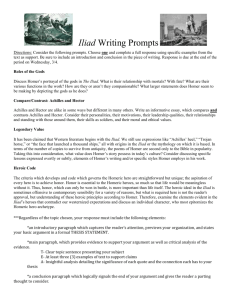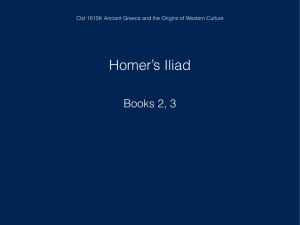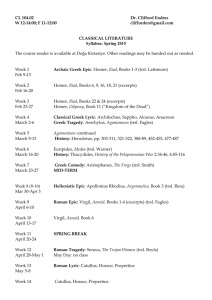Iliad Teacher Guide Sample
advertisement
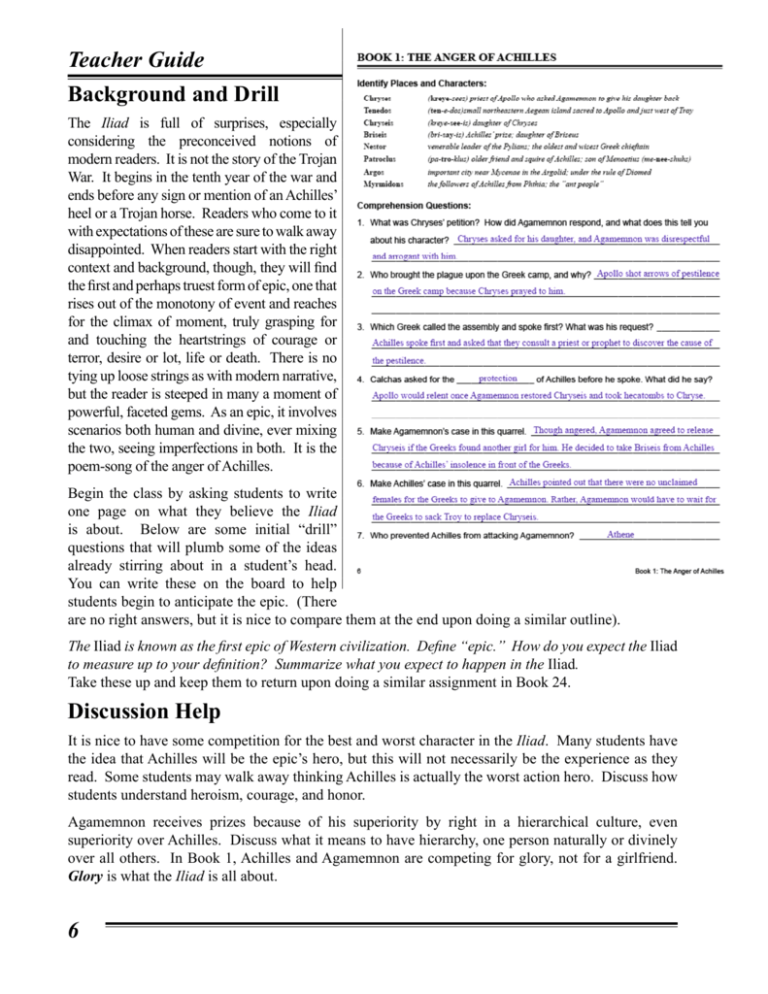
Teacher Guide Background and Drill The Iliad is full of surprises, especially considering the preconceived notions of modern readers. It is not the story of the Trojan War. It begins in the tenth year of the war and ends before any sign or mention of an Achilles’ heel or a Trojan horse. Readers who come to it with expectations of these are sure to walk away disappointed. When readers start with the right context and background, though, they will find the first and perhaps truest form of epic, one that rises out of the monotony of event and reaches for the climax of moment, truly grasping for and touching the heartstrings of courage or terror, desire or lot, life or death. There is no tying up loose strings as with modern narrative, but the reader is steeped in many a moment of powerful, faceted gems. As an epic, it involves scenarios both human and divine, ever mixing the two, seeing imperfections in both. It is the poem-song of the anger of Achilles. Begin the class by asking students to write one page on what they believe the Iliad is about. Below are some initial “drill” questions that will plumb some of the ideas already stirring about in a student’s head. You can write these on the board to help students begin to anticipate the epic. (There are no right answers, but it is nice to compare them at the end upon doing a similar outline). The Iliad is known as the first epic of Western civilization. Define “epic.” How do you expect the Iliad to measure up to your definition? Summarize what you expect to happen in the Iliad. Take these up and keep them to return upon doing a similar assignment in Book 24. Discussion Help It is nice to have some competition for the best and worst character in the Iliad. Many students have the idea that Achilles will be the epic’s hero, but this will not necessarily be the experience as they read. Some students may walk away thinking Achilles is actually the worst action hero. Discuss how students understand heroism, courage, and honor. Agamemnon receives prizes because of his superiority by right in a hierarchical culture, even superiority over Achilles. Discuss what it means to have hierarchy, one person naturally or divinely over all others. In Book 1, Achilles and Agamemnon are competing for glory, not for a girlfriend. Glory is what the Iliad is all about. 6 Teacher Guide Questions to Mark for Test: Students should mark the following items in their study guides, which they will be responsible for on their test: Identifications: Chryses, Chryseis, Briseis, Nestor, Patroclus Comprehension Questions: Numbers 4, 5, 6, 8, 9, 11 Quotations: “Sing, O goddess, the anger …” — Homer’s appeal to the Muse Teacher Notes At the end of each lesson you will tell students the short list of information which they will be responsible for on their test. Since this is the first lesson, spend more time explaining testing and study expectations. You will want to repeat this periodically before the first test, and even after that, so that students can internalize the course expectations. There will be three tests for the Iliad and three for the Odyssey. Each Iliad test IS cumulative, but students will only need to study new highlighted material and the last test (not all highlighted material from past sections). Iliad tests will come after Book 10, Book 18, and Book 24. The final test will have slightly greater weighting, but generally student performance is lowest on the middle test. At that point, the material has grown significantly, but the book is not finished. Students seem to expect that the test will not be more difficult than the first and might study less. The most important reminder at the mid-point is that students must study the last test AND the new material. To focus on one and not the other will greatly hurt performance. All students should clearly circle the ID, Question #, and Quotation bullet points for each week as noted in the Questions to Mark for Test section above. The students should memorize the place/character for the ID (there will be no word bank to help with memory or spelling, and more than 2 letters off spelling will be considered wrong). Any part of a comprehension question can be tested as a multiple choice or short answer. Quotations will be given. A student should know who is speaking and to whom—again no word bank or other helps will be given. Students will memorize the first lines of each epic and a speech in Book 9. 7 Teacher Guide Background and Drill Drill students from the highlighted Identifications, Comprehension Questions, and Quotations from the previous lesson. Remind students to review these often (perhaps make flashcards as well). The Iliad is part of the Epic Cycle, a series of poems referred to in part by Herodotus, Euripides, Aristophanes, Plato, Aristotle, and many others. This helps to explain the small window of the war that it details. While only fragments remain from the other eleven or more poems, details about the Trojan War are often repeated from other epics by writers like those above. It should be noted that the varied religious, historical, and genealogical information given in Homer is often contradicted in other places. Students should not worry if a god or human’s genealogy differs from what they have read elsewhere. They also should not build their understanding of Greek and Roman religion only from Homer. While ancient Greeks generally agreed that this was their greatest epic, it was never their only literature. Book 2 gives an excellent example of an ancient “catalog” from war. Greeks included these in their later historical writing (Herodotus has well over 100 pages of this), and it was a common form throughout the ancient world. An Egyptian temple or tomb would be incomplete without some catalog of the builder-pharaoh’s expeditionary forces. This listing was meant to impress readers by the sheer size of forces. It is clear that the chief Greek, Agamemnon, is the one with the most men. While this might seem like dry reading, it proves to be an excellent reference later when one is trying to sort through who commanded the Locrians and on which side the Paeonians fought. When students ask about a person or group, have them check this catalog for themselves. That is historical research. Drill students from the highlighted Identifications, Comprehension Questions, and Quotations from the previous lesson. Remind students to review these often (perhaps make flashcards as well). Discussion Help The Greek idea of divinity is not a Christian ideal. The gods on Olympus are fickle and often have conflicting allegiances. A god may be pleased or displeased with sacrifice depending on the moment and the person offering. Greek gods are very human, with personalities, facing fears and even shame on occasion. After sacrificing an animal to a god or gods, the Greeks eat the meat. Ajax son of Telamon = Ajax the Greater Ajax son of Oileus = Ajax the Lesser (but quicker) 8 Teacher Guide Questions to Mark for Test: Students should mark the following items in their study guides, which they will be responsible for on their test (Remind students to clearly circle the ID, Question #, and Quotation bullet point): Identifications: Eurybates, Thersites, Scamander, Iris Comprehension Questions: Numbers 1, 3, 4, 11 Quotations: “Odysseus has done …” — the Greeks about Thersites Teacher Notes Recommend or require students to make flashcards to prepare for testing. Students should have reviewed “The Friends and Foes of Homer’s Iliad” in the Appendix of this study guide by this point. The teacher should regularly ask who these characters are. Students should be retested over that material until they get a perfect score. It makes a great difference while reading when the student has mastered these. Testing Note: Students must spell all Identifications correctly (within two letters is a good rule of thumb unless a misspelling changes the answer to something else—Chryses and Chyrseis have one letter different; Tartarus and Gargarus in Book 8 have two letters different). Therefore, students should study/practice spelling these during their regular study. The students will have the italicized definition on the test, and there will be no word bank for the places or characters themselves. Now is the time to establish good study habits! Essays and Assignments Draw or reference a map of Asia Minor and the Aegean while teaching Book 2. Print a copy for students and ask them to write in the places themselves. Excellent (and free!) blank and labeled maps of the Ancient world can be found on the Ancient World Mapping Center website hosted by UNC Chapel Hill. Make a transparency for quick reference while teaching. A sense of place greatly heightens the meaning and immediacy of the epics. A map including the Greek territories will also be immensely helpful when you begin Homer’s Odyssey. Find the various map options at: http://www.unc.edu/awmc/mapsforstudents.html 9
